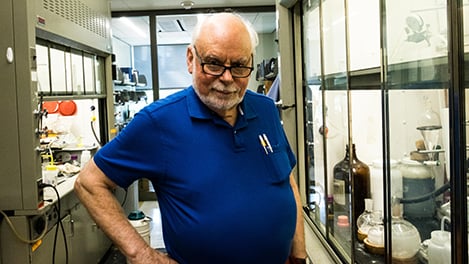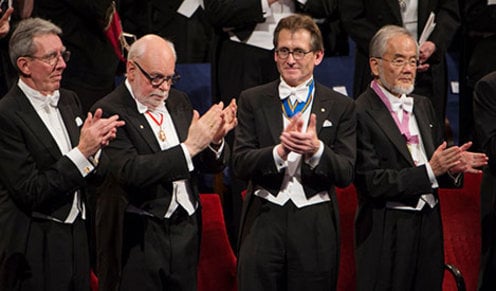Interview with Sir Fraser Stoddart on 22 September 2017
“I am now labelled as a Twitter monster!”
Sir Fraser Stoddart was interviewed in his lab at Northwestern University by Nobel Media’s Rasmus Lundgren on 15 September 2017 to discuss his first year as a Nobel Laureate, what he is working on now, and why he has become such an avid Twitter user.

Sir Fraser Stoddart in his lab.
How did you first get the news that you had been awarded the Nobel Prize?
“I was in bed. It was 4.05 a.m. when I got a call. So, of course, I thought something bad had happened, either in Japan or in the UK, where my daughters live. When I answered the phone and got told about the Prize, I also thought it could be a hoax. Fortunately, I am good at detecting English being spoken by people of different nationalities. I soon understood that: ‘Yes, this person is speaking Swedish-English’. Then I knew it was for real.”
It has been a while since you conducted the research on molecular machines for which you received the Nobel Prize. What are you working on now?
“I am 75 going on 76 years old. One of the projects that I am most excited about is giving the 30 to 35 very bright young people in my lab, from all over the world, pretty much free rein to do what they like. If only one or two of them come up with something out of this world, it would be a rewarding experience. The Prize has done a lot to open up these opportunities as well as funding for the project.”
Tell me about your first year as a Nobel Laureate.
“I don’t think it’s sensible to see it as anything other than fun. For example, I got my own parking place with a lovely purple little board that says it is reserved for me. I have spent much more time away this year than I used to. Sometimes I am not home more than 24 hours: I go home, open my suitcase, put clothes in the washer, get a new set of clothes, and then I go off to the next place. I have got traveling down to a fine art.”

At the Nobel Prize Award Ceremony, from left: Chemistry Laureates Jean-Pierre Sauvage, Sir J. Fraser Stoddart and Bernard L. Feringa. Far right: Medicine Laureate Yoshinori Ohsumi.
Copyright © Nobel Media AB 2016
Photo: Pi Frisk
“Unforgettable. I think this is a week that has been choreographed down to the last detail. Everybody was of the mind that the diversity of the experience was amazing. One of the great joys of Stockholm was spending time with my co-Laureates. There have been Laureates in the past who have been at each other’s throats and not being at all friendly. It seemed to me that we were very much one family.”
What advice would you give this year’s Laureates?
“I would hesitate to give any advice because I think it is such a personal experience. I find it difficult when people ask: ‘How do you win a Nobel Prize?’ First of all, statistically it is absolutely reigned against you. And secondly, you should not pursue your profession as a scientist with this mission as your goal. You should do your research and enjoy doing it. Maybe a Nobel Prize will happen for you, but the likelihood is very small.”
You are a tweeting Nobel Laureate. What made you decide to start using Twitter?
“Yes, I am totally taken over by Twitter. I feel that I must reach out to the young people who are coming into science at the moment. Twitter breaks down a lot of barriers and I become one of them. I was persuaded by my ex-graduate student Stuart Cantrill to start tweeting when I went to Stockholm. I took his advice and I am now labelled as a twitter monster! My mission is to try and get my co-Laureates and people from my generation involved. But my success rate has been very low. I have put the screw particularly on Ben Feringa to see if I can get him to start to tweet. He just looks at me and implies: ‘I am not getting into that, Fraser.'”
Sir Fraser Stoddart on Twitter
The Nobel Prize on Twitter
First published 26 September 2017
Did you find any typos in this text? We would appreciate your assistance in identifying any errors and to let us know. Thank you for taking the time to report the errors by sending us an e-mail.
Nobel Prizes and laureates
Six prizes were awarded for achievements that have conferred the greatest benefit to humankind. The 12 laureates' work and discoveries range from proteins' structures and machine learning to fighting for a world free of nuclear weapons.
See them all presented here.
